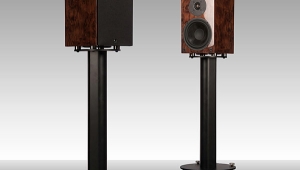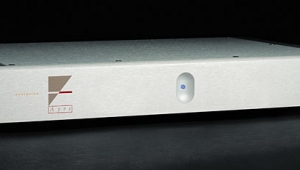| Columns Retired Columns & Blogs |
The Fifth Element #44 Page 3
The other side of the coin: Despite the many fine qualities of a more likely candidate for "integrated amplifier for all seasons," Audionet's excellent SAM V2 (see this column, June 2006, Vol.29 No.6), it did not excite in me quite the same emotional response as the Filarmonía SE.
 With the Verity Audio Rienzis
With the Verity Audio Rienzis
I had been curious for some time to hear a speaker from Verity Audio. US representative John Quick, of Tempo Sales & Marketing, lent me a pair of the upper modules from the Rienzi system ($3200–$3600/pair and up, depending on finish). My intention was to try a different pair of speakers from a price tier likely to be shopped in by those putting together a system that included the Ars-Sonum Filarmonía SE.
The Rienzi Monitor is half of the full Rienzi model (the bass module costs ca $4800/pair), and it is handsomely made. My review pair was in the highest-quality piano-black lacquer finish I have ever seen. The cabinet is 13.5" tall, 8.5" wide and 10.5" deep at the base, and 7.5" wide and 9.25" deep at the top—gently tapering but not really pyramidal. The drive-units are a 0.75" recessed soft-dome tweeter and a 6.5" midrange. The front panel is covered in a black felt-like fabric. The review pair arrived in the extra-cost ATA transit case, with fitments not only for the speakers but the binding posts (the cabinet rear has threaded inserts for them), owner's manual, isolation platforms, and magnetically attached grilles. A first-class presentation all around.
The Rienzi is a sealed-box design. Sealed-box bass loading has the advantages of better group-delay performance, a smoother impedance load, and more uniform low-frequency rolloff. The disadvantage is that ported enclosures, despite drawbacks that are mirror images of the virtues of sealed-box designs, are more efficient at getting more bass out of a small box.
The good news is that the Rienzi was blindingly electrostatic-fast, yet not harsh or brittle—at least not with the Filarmonía SE. Although I think that, overall, the Verity Rienzi and the Wilson Benesch Arc have more in common than not, the Rienzi came across as a "clarity" speaker, the Arc as a "warmth" speaker. Listening through the Rienzis to John Coltrane's "Acknowledgement," from A Love Supreme, I couldn't remember hearing as clearly before that the vocals are overdubbed.
A friend gave me a surprise gift of a CD-R made from a legal download of Anna Netrebko's achingly beautiful Russian Album (Deutsche Grammophon 000815302). The (apparently) download-only bonus track of the soaring duet "O Soave Fanciulla," from La Bohème, played back through the Filarmonía SE and Rienzis, engendered a case of whole-body goose bumps. This was all to the good—the Rienzi is a wonderful speaker.
But you hear a "but" coming: The two-way Rienzi Monitor is intended to be the upper module of a complete three-way system. The combination of the Rienzi's speed, lean or muscular tonality, and sealed bass loading added up to a speaker that could be a tad frustrating for its bass reticence—at least with the Filarmonía SE. And I approve of the uncompromising choice of sealed-box loading in the interest of greater transparency, even if the bass response of the Rienzi Monitor does somewhat suffer.
The bright side of all that is that you can buy the Rienzi Monitors, and then, when your circumstances permit, add the bass modules, and you'll have a complete, nearly full-range system. However, if your plan is not eventually to add the bass modules, I recommend careful audition, and selection of an amplifier well-matched to these speakers and to the size of your room.
Furman Sound IT-Reference 20i
When my listening to the Ars-Sonum Filarmonía SE had passed the 100-hour mark and the amp continued to emit a slight hum, Bobby Palkovic suggested that I try a balanced power conditioner. Balanced power separates the usual 120V hot leg of wall current into plus and minus 60V legs.

The IT-Reference 20i ($3499) is Furman Sound's top-of-the-line power conditioner. It weighs 81 lbs, and provides four duplex outlets offering balanced and power-factor-corrected power, as well as two duplex outlets offering unbalanced power, for high-current-draw power amplifiers. The 20i is protected from ground faults and offers connections for protecting telco and cable lines from surges. The industrial design is understatedly handsome. Unlike some other power conditioners, the IT-Reference 20i does not offer a front-panel convenience outlet. Given its comparatively small current draw, I plugged the Filarmonía SE into one of the 20i's balanced power outlets.
The IT-Reference 20i is built like a tank, and worked flawlessly. It brought a slight lowering of the noise floor without any reduction in dynamics. To my annoyance, the Filarmonía kept on hummin', though that problem eventually solved itself over time, and it was hardly the Furman's fault.
Furman claims that the 20i can handle virtually any instantaneous voltage surge from lightning or commercial power. Owners of ambitious systems, especially A/V systems that connect to the outer world through phone or cable lines or satellite dishes, are well advised to invest in a high-quality power-management solution such as the IT-Reference 20i.
- Log in or register to post comments




































